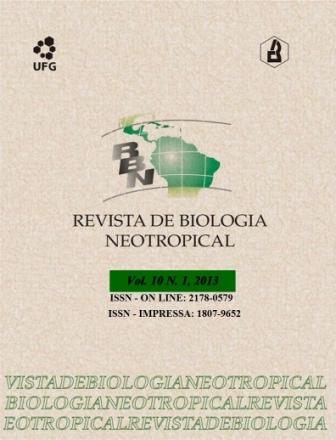Austrochthamalia (Apocynaceae, Asclepiadoideae, Gonolobinae), un género nuevo segregado de Chthamalia Decne
DOI:
https://doi.org/10.5216/rbn.v10i1.27827Keywords:
Asclepiadoideae, Austrochthamalia, América del Sur, Chthamalia, nuevo géneroAbstract
Se analiza el género Chthamalia Decne., y en base al estudio realizado se divide dicho géneroen dos entidades taxonómicas, Chthamalia Decne. y Austrochthamalia Morillo & Fontella, género nuevo.El nuevo género está constituido por las siguientes especies: Austrochthamalia boliviana Morillo & Fontella(sp. nov.), A. humifusa (E. Fourn.) Morillo & Fontella, A. major (E. Fourn.) Morillo & Fontella, y A.purpurea (Decne.) Morillo & Fontella. Dicho género pertenece a la subtribu Gonolobinae, y presenta unadistribución limitada al centro-este de América del Sur, en campos y cerrados de Brasil, Bolivia y Paraguay.En el presente trabajo se propone una nueva lectotipificación para el género Chthamalia Decne. Anatómicamente fueron observados tricomas de A. humifusa y A. purpurea.Downloads
References
Baillon, H. E. 1891. Asclepiadacées, p. 221-304. In: Histoire de plantes. Paris. London, Leipzig (Libraire Hachette & Cie., 10, fig. 157-183.
Bentham, G. & J. D. Hooker. 1873. Asclepiadeae, p. 728-785. In: Genera Plantarum ... London (William Pamplin, Lovell Reeve & Co., & Williams & Norgatte, 2, part 1.
Bukatsch, F. 1972. Bemerkungem zur doppel farburng Astrablau-Safranin. Mikrokosmo, n. 6 (8): 255.
Decaisne, J. 1844. Asclepiadaceae. p. 490–665. In: A. P. de Candolle (Ed.), Prodromus Systematis Naturalis Regni Vegetabilis, Vol. 8. Treuttel, Wurtz, Paris.
Farr, E. R., J. A. Leussink & F. A. Stafleu (Eds.). 1979. Index Nominum Genericorum (Plantarum). Regnum Veg. 100-102: 1-1896.
Fontella-Pereira, J., L. B. Santos, M. V. Ferreira, M. B. de Goes, R. J. P. Carvalho, T. U. P. Konno & V. P. Mezabarba. 2003. Asclepiadaceae, p. 65-123. In: T. B. Cavalcanti & A. E. Ramos (Orgs.). Flora do Distrito Federal, Brasil. Brasília, Embrapa Recursos Genéticos e Biotecnologia, v. 3.
Fontella-Pereira, J. & T. U. P. Konno. 2005. Chthamalia, p. 105-107. In: M. das G. L. Wanderley, G. J. Shepherd, T. S. A. Melhem & A. M. Giulietti (Coord.). Flora Fanerogâmica do Estado de São Paulo. São Paulo, FAPESP, v. 4.
Fournier, E. 1885. Asclepiadaceae. In: C. Martius, Flora Brasiliensis 6(4): 189-332.
Goyder, D. J. 2006. Rojasia reinsteited and six new names and combinations in Matelea (Apocynaceae: Asclepiadoideae). Kew Bull. 61: 31-33.
Hassler, E. 1918. Addenda ad Plantas Hasslerianas: familiae, genera et species pro flora paraguariensi nova vel in Plantis Hasslerianis I et II haud enumerate 1. Geneve.
Liede, S. 1997. Subtribes and genera of the Asclepiadeae (Apocynaceae, Asclepiadoideae)- a synopsis. Taxon 46: 233-247.
Liede, S. & U. Meve. 2004. A new combination in Matelea (Apocynaceae-Asclepiadoideae). Novon 14: 314.
Malme, G.O. 1927. Asclepiadaceae matogrossensis. Ark. Bot. 21a (12): 1-27.
Schumann, K. M. 1895. Asclepiadaceae, p. 189-306. In: H. G. A. Engler, & K. A. Prantl. Die natürlichen flanzenfamilien ... Leipzig (Wilhelm Engelmann), v. 4, abt, 2, figs. 62-92.
Woodson, R. E. 1941. The North American Asclepiadaceae. Perspective of the Genera. Ann. Missouri Bot. Gard. 23: 1-41.
Downloads
Published
How to Cite
Issue
Section
License
The expontaneos submmition of the manuscript automaticaly implies in the cession of all patrimonial rights for the Journal of Neotropical Bilogy (RBN) after publication. The autor allow the right of first publication of the article to the RBN, under Creative Commons Attribution 4.0 (CC BY-NC 4.0) Licence.
There are garanties for the authors to the authorial and moral rights, for each one of the articles published by RBN, with permissions:
1. The use of article and contents for the education and researches.
2. The use of the article and their contents, linking to the Article on the web site of the RBN, allowing the divulgation on:
- institutional closed web (intranet).
- open access repositories.
3. Preparation and divulgation of the other publication derived from the article and its content, if there is citation of the original publication by RBN.
4. Make printed copies in small quatinties for personal use.

















